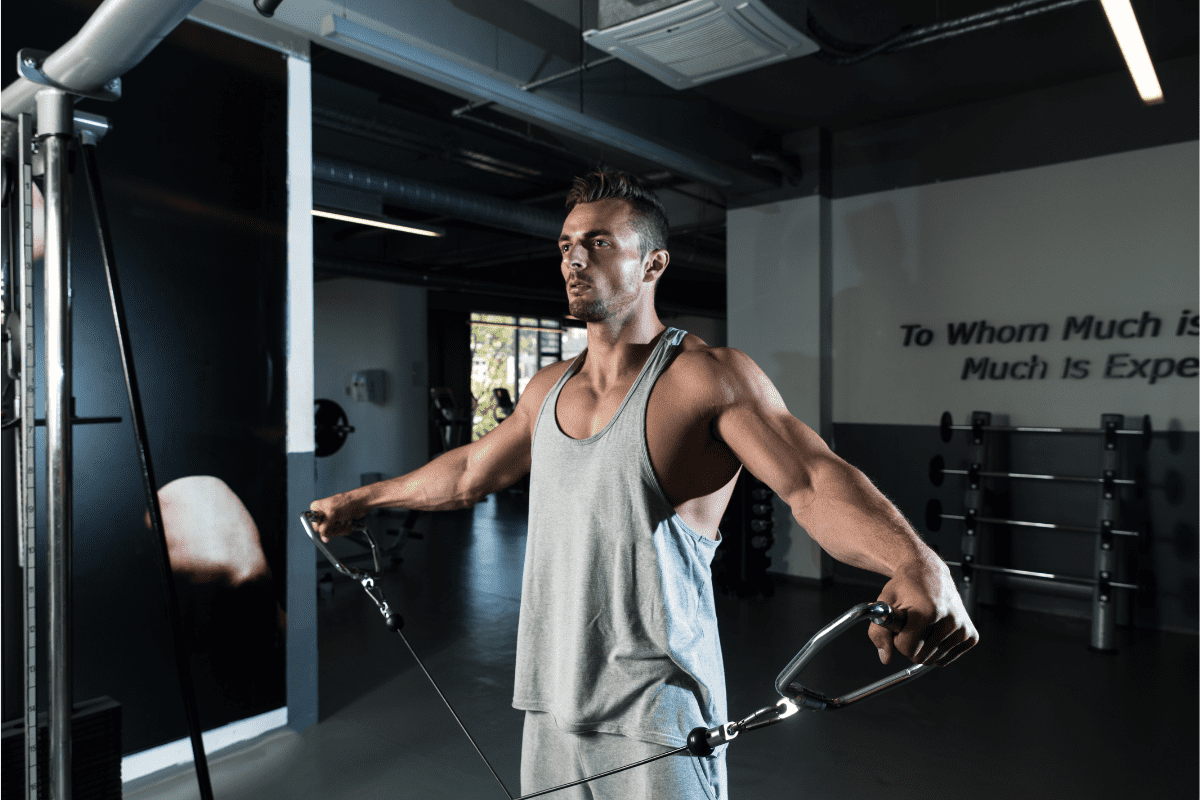10 Cable Lateral Raise Alternatives to Grow Your Shoulders
The Cable Lateral Raise is a popular exercise used to strengthen the muscles in the shoulders.
This exercise involves using a cable machine to lift weights out to the sides of the body, working the lateral deltoids, as well as the upper back and traps.
I have to admit, it’s one of my all-time favorite Saturday morning gameday workout movements. A few sets of Cable Crossovers, some Cable Lateral Raises and plenty of arms and you’re ready for the sidelines.
However, as awesome as Cable Lateral Raises may be, sometimes you may need an alternative for Cable Lateral Raises. The most obvious reason being you don’t have access to a cable machine.
Don’t worry, you’re in the right place. I’m about to give you 10 of my favorite alternatives for Cable Lateral Raises.
Alternatives for Cable Lateral Raises
I’ve tried to add as much variety as possible to this list of alternative exercises.
I’ve included exercises that use a variety of equipment, from barbells to dumbbells to even resistance bands. There are beginner-friendly movements and movements for more advanced lifters.
My goal is that no matter what equipment you have access to or what your level of experience is, at least one of these options will be a good fit for what you’re looking for.
Dumbbell Lateral Raise
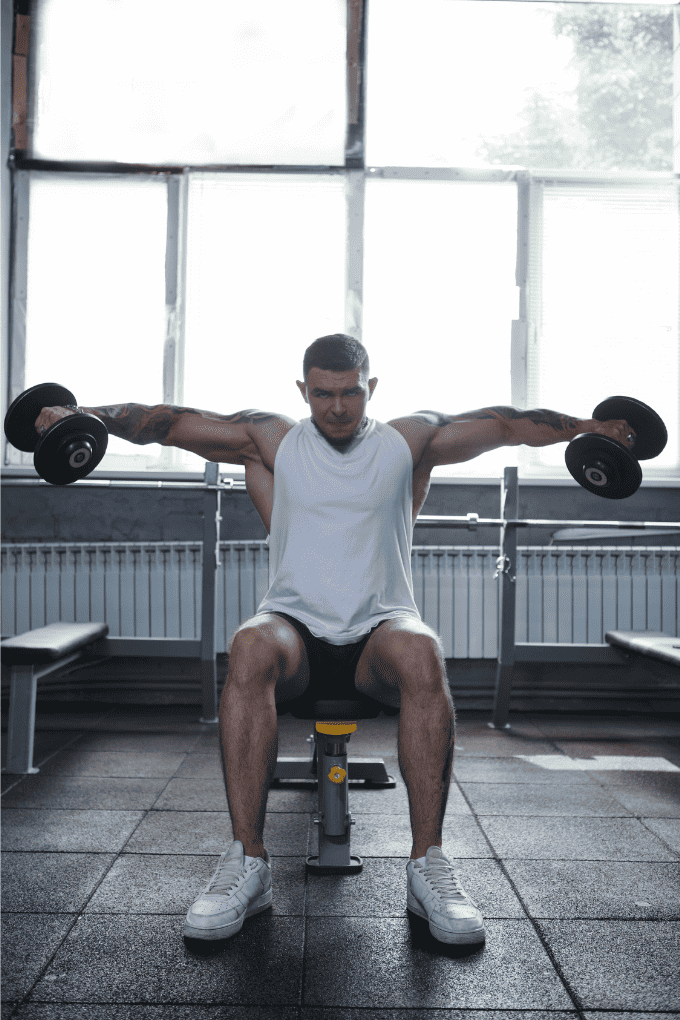
If you don’t have a cable machine, the most obvious alternative is the Dumbbell Lateral Raise.
Same movement, pretty much the same benefits – just with a different piece of equipment.
Equipment Needed
- Dumbbells
Instructions
- Hold dumbbells-palm in, arms straight down at sides.
- Raise dumbbells in semicircular motion slightly above shoulder height tilting the head of the dumbbell down.
- A slight pause, then lower to starting position under control.
- Keep your arms straight with just a slight bend in the elbow.
- Use the same path to continue repeated reps.
- Exhale up, inhale down.
Coaching Points
To keep the focus on the medial delt when doing Dumbbell Lateral Raises, make sure to keep your palms down at the top of the movement.
Many lifters like to pull back, instead of lift straight out to the sides, which brings the stronger muscles of the upper back into play.
Also, always start the movement at the side of the thigh. Bringing the dumbbells in front of the body allows for more of a momentum swing and takes away from the stress placed on the delts.
Band Lateral Raise
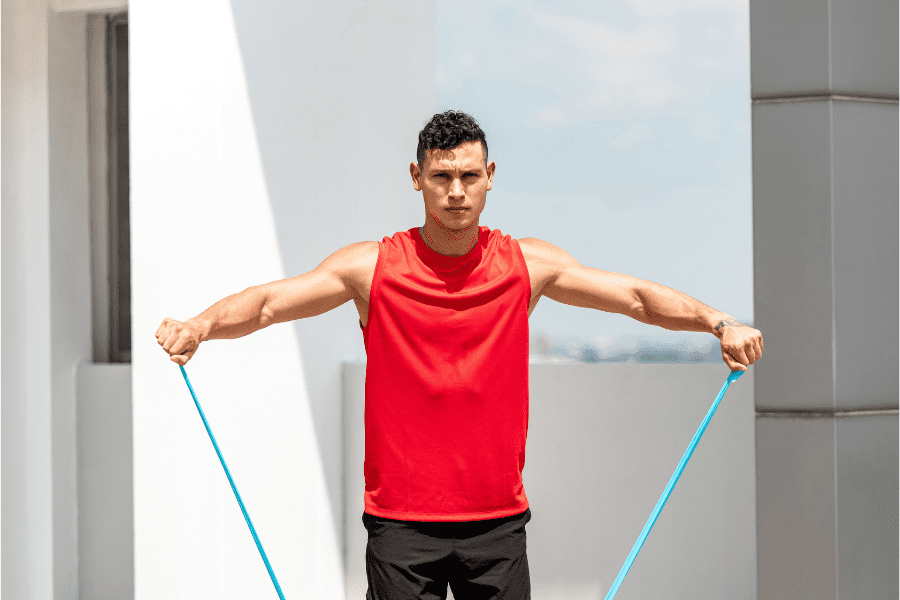
Like Dumbbell Lateral Raise, Band Lateral Raise is another Lateral Raise variation with a different piece of equipment – this time with a resistance band.
This is a great alternative for the lateral deltoids when traveling and throwing a cable machine in your suitcase isn’t really an option.
Equipment Needed
- Resistance Band
Instructions
- Stand on the center of the resistance band with your feet shoulder-width apart, and hold the ends of the band in each hand*.
- Keep your palms facing your body and your elbows slightly bent. This is your starting position.
- Slowly raise your arms out to the sides until they are parallel to the ground.
- Hold this position for a moment, and then slowly lower your arms back to the starting position.
- Repeat this movement for the desired number of repetitions.
Coaching Points
When doing Band Lateral Raises, if your resistance band is not long enough to use both arms at the same time, simply stand on the band and raise one arm at a time instead.
Keep your core engaged and avoid swinging your arms or using momentum to lift the band. This will help you to isolate the muscles in your shoulders and get the most benefit from the exercise.
You can adjust the resistance of the band by changing your stance or by using a band with different levels of resistance.
Barbell Upright Row
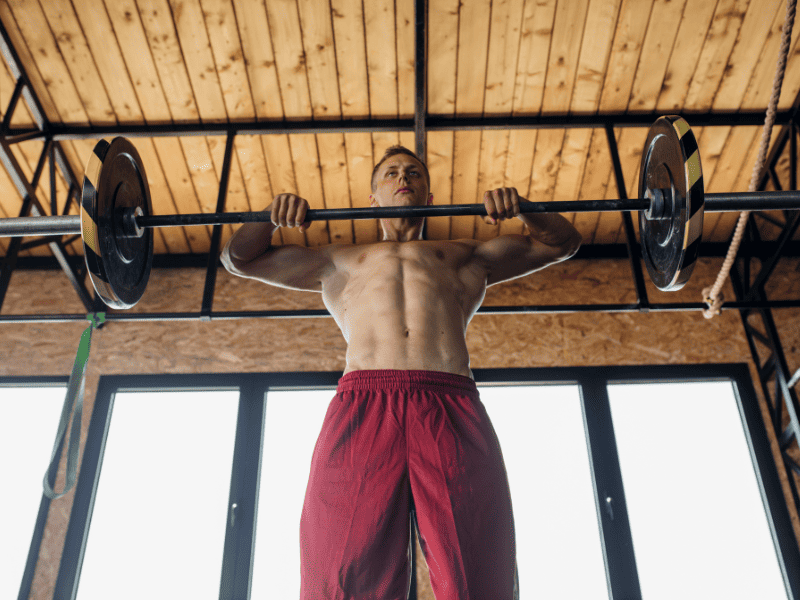
Barbell Upright isn’t just a great exercise for the upper traps, they also do an excellent job at hitting the lateral deltoid.
Equipment Needed
- Barbell
- Bumper Plates (or Iron Plates if not dropping the bar after sets)
Step-by-Step Instructions
- Grasp bar about shoulder-width apart.
- Hold the barbell with palms down.
- Start with the bar at arm’s length.
- Flex your knees slightly.
- Pull the bar upward along the abdomen and chest toward the chin.
- At the top, the elbow should be higher than the wrist, and above the shoulders.
- Lower the bar slowly and under control to the front of the thighs.
- Do not jerk.
- Keep the bar close to the torso.
Coaching Points
The biggest mistake I see, by far, with Barbell Upright Rows is swinging way too much to lift the bar. A little swing is okay if you’re trying to grind out the last rep or two of a set.
However, if you’re having to rock your torso for every rep then the weight is too heavy. Take some weight off the bar and use proper form.
Dumbbell Upright Row

Many lifters (myself included) prefer Dumbbell Uprights Rows over Barbell Upright Rows because they can be more comfortable on the wrists and/or shoulders.
Dumbbells allow the lifter to control the angles and range of motion better than with a barbell.
If Barbell Upright Rows bother your wrists or shoulders, you may want to give the dumbbell variation a shot.
Equipment Needed
- Dumbbells
Step-by-Step Instructions
- Grab two dumbbells and start with them at arm’s length in front of the thighs, palms toward the body.
- Flex knees slightly and stand upright with good posture.
- Pull the dumbbells upward along the abdomen and chest toward the chin.
- At the top, the elbow should be higher than the wrist, and above the shoulders.
- Lower the bar dumbbells and under control to the front of the thighs.
- Do not ‘jerk’ or ‘rock’ the weight up and keep the dumbbells close to the torso thoughout.
Coaching Points
The biggest mistake I see, by far, with Dumbbell Upright Rows is swinging way too much to lift the weight.
A little swing is okay if you’re trying to grind out the last rep or two of a set, however, if you’re having to rock your torso for every rep then the weight is too heavy. Grab some lighter dumbbells and use proper form.
Overhead Press
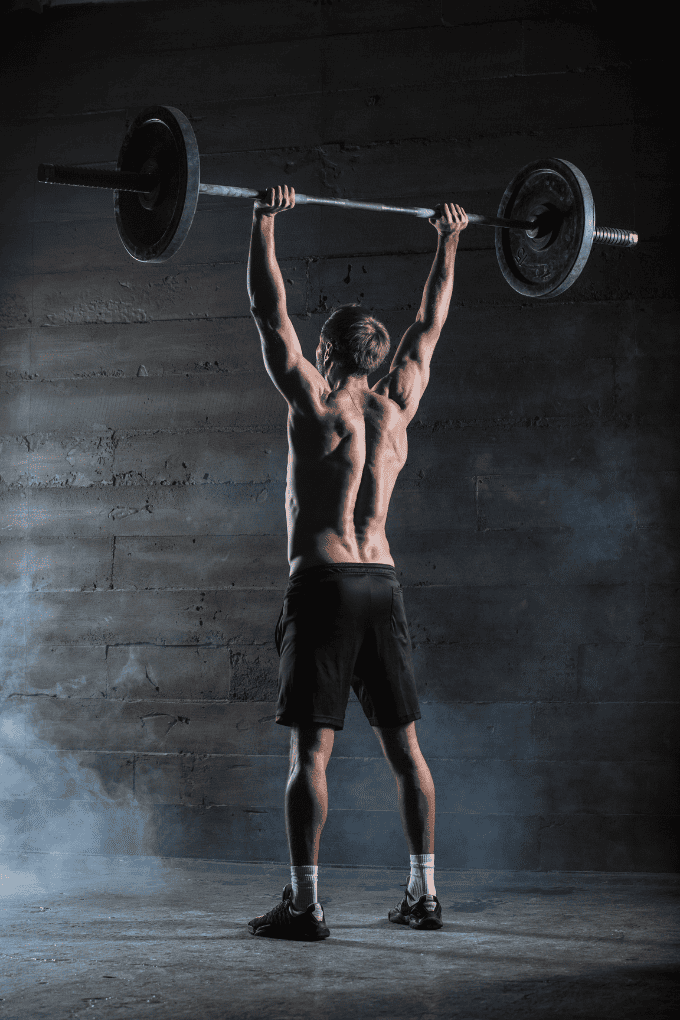
Now, let’s transition into some pressing movements. Overhead Presses will work not just the lateral deltoid, but the anterior and posterior deltoids as well.
If you’re serious about developing shoulder strength, it’s hard to not have Overhead Pressing in your program.
Equipment Needed
- Barbell
- Bumper Plates or Iron Plates
Instructions
- The grip should be shoulder-width apart.
- Elbows should be under bar.
- Torso should be erect.
- Move the bar off the rack.
- Keep your chest up.
- Push the bar up to full elbow extension.
- As soon as the bar passes the head – ‘pull the head through’ – so that the bar is being locked out directly over the ears.
- Keep elbow pointing out to the side until arms are fully extended.
- Do not forcefully lock out the elbow.
- Lower the bar slowly and under control to shoulder level.
- Do not jerk or bounce at the bottom.
Coaching Points (Common Mistakes)
The biggest mistake I see with Overhead Presses is overarching the back and leaning back way too much (hyperextension of the spine). This places too much unnecessary stress on the low back that should be avoided.
Personally, I like to use a staggered stance because I feel it helps me to keep from leaning back too far and placing that stress on the low back.
It’s a technique I’ve used often with athletes as well experiencing the same problem. If that’s an issue for you as well I would definitely recommend giving a staggered stance a try.
The other common mistake that I see is bending the knees and using the legs too much. A slight bend is okay, especially when trying to squeeze out that last rep or two of the set.
But, if the exercise starts to resemble more of a Push Press as opposed to a Shoulder Press then the weight should be lowered.
Arnold Press

An overhead press variation named after the legend himself, Arnold Presses alter the movement pattern slightly to put even more time under tension on the shoulders.
Equipment Needed
- Dumbbells
- Bench (If you prefer doing the Arnold press seated but you can do the exercise standing as well)
Step-by-Step Instruction
- Stand* with the dumbbells next to you.
- Hinge and the waist and bend the knees until you can grab the dumbbells.
- Keep a neutral spine, and a nice flat back, and lift the dumbbells into your pressing position.
- You will start with the palms facing you.
- As you press the dumbbells up, rotate the dumbbells as you press, and at the top of the movement, your palms will be facing away.
- As you lower the dumbbells back to the start, rotate the dumbbells until your palms are facing you.
Coaching Points
*Arnold Presses can also be done seated as in the video above.
This is an exercise that is programmed for hypertrophy. Control the weight and focus on time under tension. This one is going to burn, so grit your teeth, and enjoy it!
Keep the core engaged as you press. If you feel you are arching your back as you reach closer to lockout, consider going down in weight.
Dumbbell Curl and Press
Do I really need to sell you on getting extra biceps work in with your shoulder workouts?
Equipment Needed
- Dumbbells
Step-by-Step Instruction
- Grab dumbbells that you can perform at least 8 perfect reps with here.
- Standing nice and tall, hammer curl the dumbbells up to shoulder height.
- From here, press the dumbbells straight up overhead to lockout.
- Slowly bring the dumbbells back and down to shoulder height.
- From here, slowly return the dumbbells to your side.
Coaching Points
Go slow! Time under tension is key here. Feel the burn, especially on the way back down.
It’s easy to get out of control and begin swinging dumbbells all over the place with Curl and Presses. Stay in control of the weight throughout.
Hang Muscle Snatch
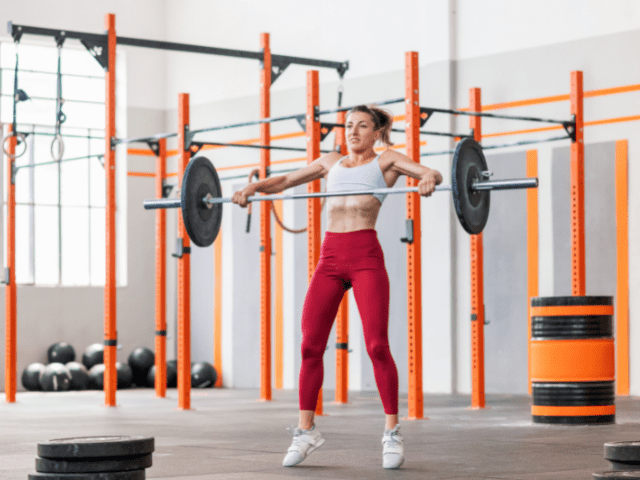
Probably not the type of exercise you came here looking for, but the truth is Hang Muscle Snatch can develop a ton of shoulder strength (and size).
By not dropping the hips in the catch position, the shoulders bear more of the burden to finish the lift to full extension. With the right amount of weight, it’s extremely effective at challenging the shoulders and upper back.
Equipment Needed
- Barbell
- Bumper Plates
Instructions
- Using a snatch grip (hands outside the snatch rings), pick up the bar and stand tall.
- Pull the shoulder blades back and engage the lats to lock the back in the place.
- Put a slight bend in the knee and hinge forward by pushing the hips back and letting the bar slide down the thigh.
- Stop once the bar reaches the bottom of the thigh, just above the knee. Shoulders should be above or slightly in front of the bar.
- Now, explosively extend the hips and pull the bar high once triple extension of the hips, knees and ankles has been achieved.
- Finish the movement by rotating the hands above the elbow.
- The finishing position should be with the lifter fully extended. This is much different than most other variations of the snatch where the lifter catches in a full or quarter squat.
Coaching Points
Once the weight gets heavy enough with Hang Muscle Snatch, the natural adjustment of the lifter will be to want to bend the legs to dip slightly under the bar in order to get full arm extension.
Resist this urge to want to dip the legs. If the lift isn’t possible without bending then lower the weight.
Sledgehammer Slams
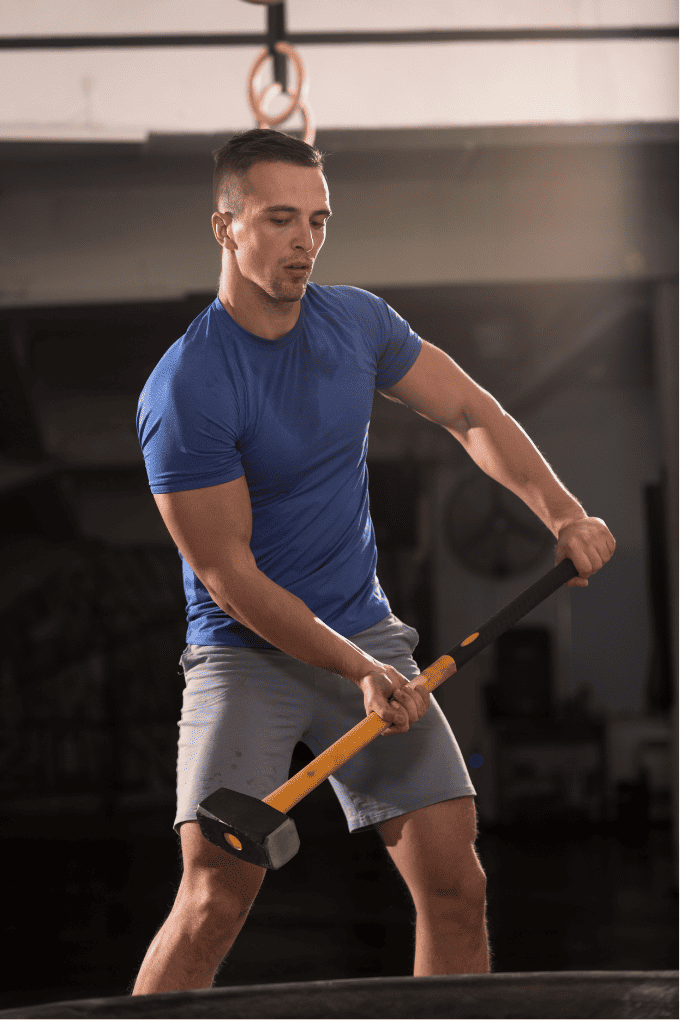
Looking for something a little outside the box?
Sledgehammer Slams are great for working the shoulders, core and even the cardiovascular system. They’re an excellent option for replacing Cable Lateral Raises and adding variety to your workouts.
Equipment Needed
- Sledgehammer (10-20 pounds)
- Tractor tire
Step-by-Step Instruction
- Hold the sledgehammer with one hand on the end of the handle and the other hand about 3/4 of the way toward the head of the hammer.
- Take a strong athletic stance. Slight bend in the knee and hips back.
- Always remember to engage the core.
- Pull the hammer up and rotate the hammer until it is slightly overhead.
- Your arms should still be slightly bent.
- Forcefully bring the hammer down to slam
- As the hammer approaches the tire, you should feel your top hand slide and they will be together at impact.
- Alternate sides until you finish your set.
Coaching Points
Be sure to select a hammer that is not too heavy when doing Sledgehammer Slams. If the hammer is too heavy, you will not have proper form and you will not benefit from the exercise
Focus on force production. Slam the tire as hard as you can.
Remember to engage the core. As you bring the hammer down, really pull down with those lats and abs to get the best strike possible.
Farmer’s Walk
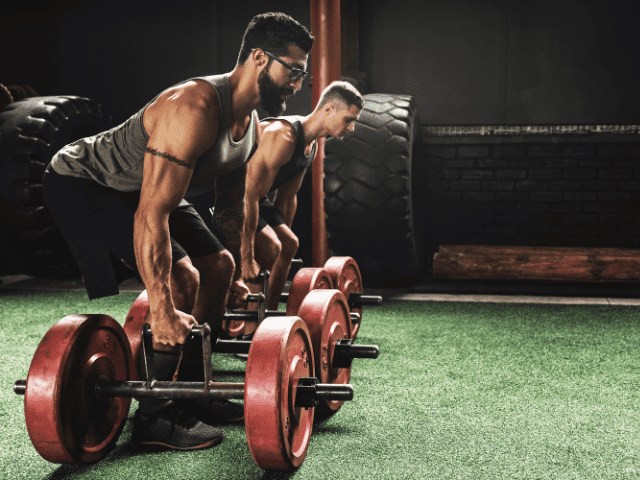
Another outside-the-box exercise that can tax the shoulders and upper back is the Farmer’s Walk.
They can be done with strongman-type implements like the ones in the pic above or simply with a set of dumbbells.
Equipment Needed
- 1 kettlebell or dumbbell if doing single arm carries
- 2 kettlebells or dumbbells if doing both arms
- A trap bar is also an awesome implement for farmer’s walks
FYI: There are also very-specific pieces of equipment (shown above) designed almost solely for Farmer’s Walks. If you ever find yourself in a Strongman Gym, you may run into some of these. They can be a blast to train with.
Step-By-Step Instructions
- For the sake of these instructions, I am going to assume you are carrying 2 kettlebells or dumbbells. The single arm and trap bar options are essentially the same movement with slightly different benefits. I will talk more about these options in the coaching points
- With the kettlebells at your side, hinge at the waist and bend at the knee until you can pick them up. Remember to always lift with a nice flat back, neutral spine, and a tight core.
- Hold the kettlebells slightly away from your sides.
- Keep the core tight, shoulder blades back, and posture up tall.
- Walk with extreme control. Generally, I prescribe walking 20 yards out and 20 yards back for a set but longer distances are fine as long as the form remains intact.
- Focus on crushing the handles with your grip. Avoid any trunk deviation side to side or front to back. Try to walk as controlled as you possibly can.
Coaching Points
Choosing an appropriate weight is critical here. The focus is to keep the core tight and perfect posture.
So if you go too heavy and your form deteriorates, you won’t get the full benefit of Farmer’s Walks and may hurt yourself.
You also don’t want to go so heavy that you can’t hold the dumbbells slightly away from your sides. The reason this is important, is you don’t want your legs constantly bumping into the weight as you walk.

Get Shredded… For Free
Get a free workout Monday through Friday, posted right here on Horton Barbell. These workouts are designed to help you get strong, in shape and look great at the beach!
Final Thoughts
I love Cable Lateral Raises as an exercise to develop strong shoulders, but sometimes Cable Lateral Raises are just not an option.
Whether you’re lacking proper equipment or are just looking for a different movement to add some variety to your program, I hope at least one of these alternatives I’ve listed here is a good fit for you.

